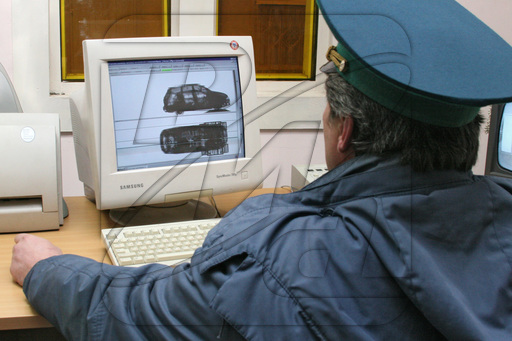Monuments
The first monument to F. M. Dostoevsky was installed in Moscow at the Color Boulevard in 1918 in the framework of the Leninist Monumental Propaganda Plan - the Granite Statue of the Sculptor S. D. Mekurova 1911-1913. In 1936, the monument was postponed to Dostoevsky Street to the Mariinsky Hospital, where the writer was born. In many places associated with the name of the writer, monuments or busts are established.
Installed in 1936 at the building of the Mariinsky Hospital, in the Northern Flegene whose writer was born and lived until 16 years. His museum-apartment is also located in the hospital. The author of the sculpture is Sergey Mercurov. Created back in 1914, is the first permanent granite monument of Lenin monumental propaganda. In 1956, Architect Isididor French created for the statue of a pedestal.
Statue and pedestal are made of Swedish granite. The writer is depicted in full growth. He sniffed, the palms are hooked on the chest, the robe slides from the left shoulder. The sculptor determined the monument as a figure with two axes and one center outside the statue. The silhouette of the writer changes with the change in an angle.
The poet Demyan Poor dedicated to Monument poem:
Deeper and lower, to the rise of steep,
where is given to the bouquet in hand
Tubular area Boulevard Color
where Dostoevsky froze in the tetanus
In 1960, the monument was taken under state protection.
Monument F.M. Dostoevsky in Baden-Baden (Seufzerallee, 76530 Baden-Baden, Germany)

Monument F.M. Dostoevsky in Baden-Baden personifies the instability of the life of the writer, familiar with his biography and novels. The monument was built by sculptor Leonid Baranov. In Baden-Baden, the monument appeared in 2004.
The author of the sculpture wanted a monument to be located in the backyard of the Badensky casino, symbolizing the time of the addiction of the writer to the game, but it was decided to put a monument in the Rothenbachtal Valley. To get to the monument, you need to pass by the building, in which the prison was previously located.
Dostoevsky liked Baden-Baden, and the writer loved to walk through this German resort, admiring his magnificent views.
Bust FM Dostoevsky in Wiesbaden (Germany, Hesssen, Wiesbaden, Paulinenstrase, 19)
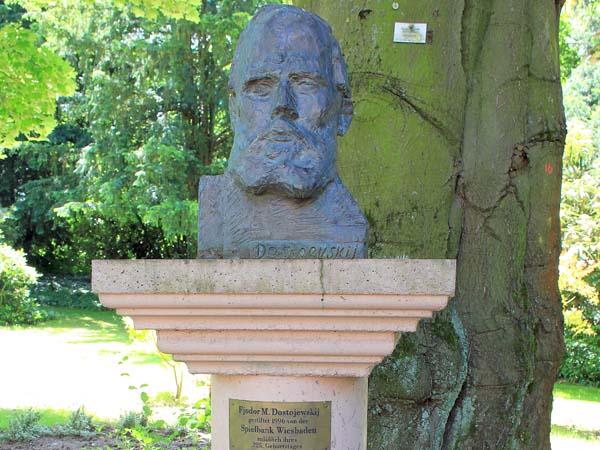
Thanks to the achievements and outstanding feats, there are some monuments. But from each rule there are exceptions. And here is one of them.
In Germany, in the city of Wiesbaded Fedor Mikhailovich Dostoevsky set a bust for losting all the money in the local casino. February 3, 1997 (but on a tablet 1996) of the year, the sculptor Gavriil Glikman presented a bust f.m. Dostoevsky made of gray granite on a pink pedestal. Why such a gift was made not clear, it certainly coincided with the date of birth of the writer - 175 years since the birth of F.M. Dostoevsky.
Dostoevsky F.M. He came to Wiesbaden on therapeutic water to recover from epilepsy, but it was not easy to go to the casino and there he spent all the money that was with it (120 talers or 3,000 rubles). There are letters in which he asks for the next portion of money from his first spouse. But she apparently helped several times, but he refused. And when Once again, Fedor Mikhailovich Dostoevsky played in the casino, then took a loan from the publisher under the condition that he would give a new novel in extremely short time.
Therefore, F.M. Dostoevsky did not remain anything, how to start work and so the novel "". Casino in respect even called one of his halls in honor of F.M. Dostoevsky, although there were other celebrities there, such a magnitude, like Elvis Presley, Mikhail Gorbachev, but the halls are no longer renamed.
Monument F.M. Dostoevsky in Homburg (2014)
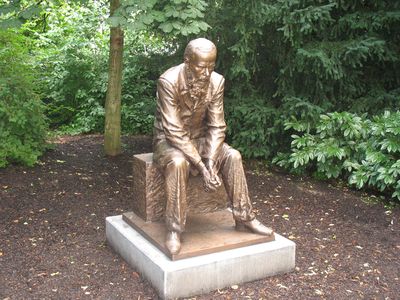 Monument F.M. Dostoevsky in Bad Homburg
Monument F.M. Dostoevsky in Bad Homburg In Bad Homburg (Germany, the administrative district of Darmstadt), a monument to Dostoevsky was installed in Kur-Park, in 2014, sculptor - N. Karlyanov.
In Bad Homburg, Dostoevsky visited three times and played the casino, repeatedly lost large amounts of money in Roulette, falling into hopeless situations. The impressions of Bad Homburg were used by the writer when writing a novel ".
Monument F.M. Dostoevsky in the giving estate (1993)
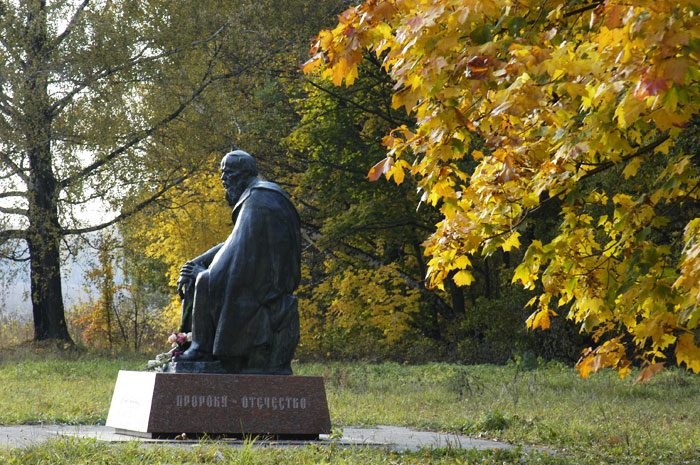 Monument F.M. Dostoevsky in the granite estate
Monument F.M. Dostoevsky in the granite estate Behind the entrance avenue on the edge of the lime grove is the monument to F. M. Dostoevsky, open on 25 September 1993. This is one of the best monuments to the writer. Authors: Sculptor - Honored Artist of Russia Yu. F. Ivanov, Architect - Honored Architect of Russia, Professor N. A. Kovalchuk.
The monument is established at the point of the gift from which the living on the Dostoevsky thread stretch in all directions: the writer looks at the gloss, to the right of him the field with a Nechaevsky graveyard and "native ashole", on the left - a small manor that keeps the memory of family tea drinking under the age of the linden And behind - shady lime grove, the favorite shelter Fedi, Misha and Andryushi Dostoevsky.
The monument to the funds of a citizen of Russia B. V. Pisareva will be erected. At the pedestal of the word "Prophet Fatherland." For the gift, this fact is a monument to the writer for private donations - very significant. He became the first sincere gift of the land on which the Russian genius tweaked, the gift, which began the beginning of good disinterested cases on the revival of the Earth of Childhood F. M. Dostoevsky.
Monument F.M. Dostoevsky in Dobrich, Bulgaria (2008)
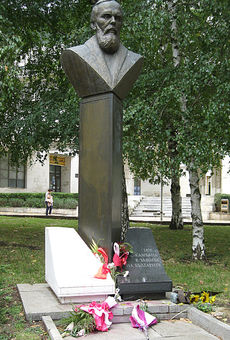
The first in Bulgaria Monument Fyodor Mikhailovich Dostoevsky was opened in 2008 in Dobrich. The Great Russian writer was born on this day 187 years ago. The monument was erected in the Central City Square between the dramatic theater them. Yordan Yovkova and art gallery.
The opening ceremony was attended by an adviser to the Embassy of the Russian Federation in Bulgaria Sergey Foshkin and the Consul General of Russia in Varna Anatoly Noglkunov.
The idea to put a monument to the writer belongs to the Bulgarian Foundation "Dostoevsky". The author of the three-meter bronze composition is the Bulgarian sculptor of Hristo Eliyev. On the pedestal of white and black marble, it is written: "1876 year. Voice-Nabat in defense of Bulgar. This is a sign of appreciation to the writer for his hot call to help the suffering of the Bulgarian people after the Turkish massacre during the April 1876 uprising.
Dostoevsky repeatedly set the question of the suffering of Bulgaria before the Russian emperor, society and the church and, together with other great representatives of the Russian people, made an important contribution to the release of Bulgaria from the Ottoman IGA.

The statue was cast in 2004 by the Russian sculptor Muzvishnikov, then for her chose a place and coordinated different legal moments (great merit belongs to the German-Russian Culture Institute in force in Dresden). And in 2006, on October 10, the discovery of the monument was held, which was confined to the 800th anniversary of Dresden and the 185th anniversary of Fedor Mikhailovich. At the opening of the monument was attended by the President of the Russian Federation Vladimir Putin and Chancellor of Germany Angela Merkel. In a solemn speech, they noted the symbolic meaning of the new monument, strengthening cultural ties between the two countries.
Find a monument is easy: it is located on the Elluba River embankment, next to the buildings of the congress center, the Landtaga of Saxony, and the Maritim Hotel. From there to hand to the main attractions of Dresden, central square and castle.
Monument F.M. Dostoevsky in Lublino, Moscow (2007)

The writer lived in Lublin in 1866, not far from the Durass Palace. Installed in Moscow, on Krasnodonskaya Street, House 2 (on the territory of GBOU SOSH No. 1148), in the yard of the school, which carries his name. On November 10, 2007, the opening of the monument was held, which was preceded by seven years of preparation. The author of the project is the sculptor Evgeny Petrovich Shishkov.
The bronze bust is placed on the pedestal of polished granite, on the front side of which the autograph writer and the inscription "without a higher idea cannot exist neither a man nor a nation. And the highest idea on Earth is only alone, and it is the idea of \u200b\u200bthe immortality of the soul of human, for all the other "higher" ideas of life, which a person can be alive is only one of her aroused. "
Monument F.M. Dostoevsky in Moscow (1997)

The monument to Fedor Dostoevsky was established in 1997 before the building of the Russian State Library in honor of the 175th anniversary of the writer and the 850th anniversary of Moscow. The authors of the monument are the sculptor Alexander Mukhivichnikov and architects Mikhail Posokhin, Alexander Gennadevich Kochaovsky, Sergey Alexandrovich Sharov.
Bronze sculpture depicts a writer sitting on a bench. He thought about something, his pose is uncomfortable, in the expression of the face you can catch a feeling of hopelessness and sadness. The statue is placed on the granite pedestal of non-standard form. The inscription "Dostoevsky" was carved on his front, on the back - the bas-relief of the Neva embankment in St. Petersburg. Due to the unusual posture of Pyodor Dostoevsky for the monument, the name "Monument to the Russian hemorrhoid" or "At the reception of the proctologist" was entrusted with the people. The author of the work comments on the mocking nickname of his creation:
"Well, in my opinion, good. This illustrates the culture of residents. People who all get, called Dostoevskiy. Fyodor Mikhailovich is interested in that he could not find a place. He tried to dig a little anthill from human passions. I wanted to express it. "
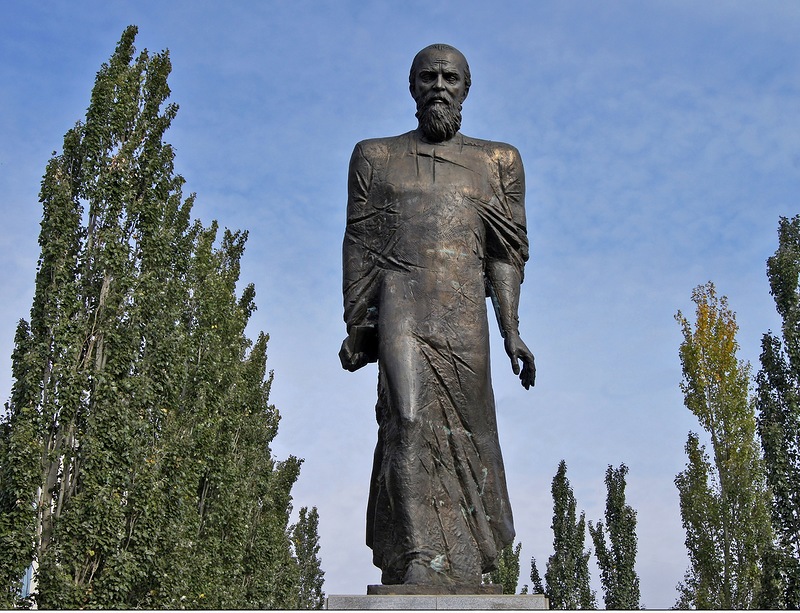
As a sign of respect, the Russian writer of World Value by Fedor Mikhailovich Dostoevsky on November 12, 2001, a monument was opened in Omsk.
The place where the monument was installed is not accidental. It stands at the intersection of the streets of Spartakovskaya and partisan. This place is the historical part of the city of Omsk, it is here, between the Tarsh gates of the Omsk Fortress and the building, in which the Literary Museum named after F. M. Dostoevsky is now located, the Russian writer-Katorchin was held many times.
The creators of the monument are the architect Albert Karimov and the sculptor Sergei Golovnelsev. Sergey Huddans worked on the monument to the Russian writer F. M. Dostoevsky.
On Monument, Fedor Mikhailovich is depicted by overcoming the impulse of the wind, immersed in their thoughts. In appearance, it seems to be a man with a strong character.
In Hand, the writer Katroshanin holds the Gospel, only the Holy Scripture was allowed to read Dostoevsky in Ostrog. It was here that the writer had a rethinking of life values, it was in Ostrog, he appealed to God.
Together with the pedestal, the height of the sculpture is five meters. Initially, it was concrete, and in 2007 the sculpture was replaced with bronze.
Monument F.M. Dostoevsky in St. Petersburg (1997)

The author of the monument - Lyubov Mikhailovna Kholina - created a sketch of the granite monument to Dostoevsky back in 1956 and over the next few years, refined it, but for various reasons the time to install the monument has not yet come. Only on October 30, 1988, the executive committee of Lensovet issued a decree under which the General Department of Culture, Leningrad Organizations of Architects Architects and Artists of the RSFSR announced the competition for the development of the project of the Monument F. M. Dostoevsky. In total, 12 projects were presented to the competition, and the first prize was obtained by the work of L. M. Kholina and architect V. A. Petrov. However, this project was not implemented because it was necessary to replace the sculpture of the writer on the bronze.
The necessary changes to the project were made in 1993-1994. With the participation of the son and grandson L. M. Kholina: Artist Peter Alexandrovich and Sculptor Pavel Petrovich Ignatiev. The designed sketch of the sculpture of Dostoevsky was cast in bronze at the Montument Culture Plant.
The place of installation of the monument was chosen on the initiative of the Museum of F. M. Dostoevsky and the main artist of the city of I. G. Uralov: Boulevard of a large Moscow street near the church of the Vladimir icon of the Mother of God near the house on the corner of the fork and Yamskaya (Dostoevsky) Street: It is here Dostoevsky He graduated from his days.
The monument was opened on May 30, 1997. Each first Saturday of July, Dostoevsky's days next to the monument are revealed.
The bronze figure of the Dostoevsky height of 2 m is depicted sitting, in the voltage of work on its work. The look of the writer is addressed to the Church of the Vladimir Mother of God. Sculpture is installed on a granite pedestal with a height of 1.5 m. At the pedestal, the inscription Dostoevsky is applied to the pedestal.
Monument F.M. Dostoevsky in Tallinn (2002)

In the center of Tallinn, in the park of Canuy, adjacent to the center of Russian culture, there is a monument to the classic of Russian literature, the great writer Fyodor Mikhailovich Dostoevsky.
As you know, in his youth, he often visited Rive, where Mikhail's older brother lived. Moreover, the "Revel period" was reflected in the works of Fedor Mikhailovich: in particular, it is believed that the image of a great inquisitor in "" was written off from the pastor the hound huun, with which the writer was able to intersect in the roar.
A monument to Dostoevsky in Tallinn was established in 2002. He was presented as a gift to the capital of Estonia by the Government of Moscow, as evidenced by the inscription on a high granite pedestal. The author of the project is the Russian sculptor Valery Evdokimov. The monument was erected on the initiative of Slavic cultures.
The choice of the installation site of the monument is not accidental. First, in his favor, the proximity of the center of Russian culture says. Secondly, about the park of Kanouui, who in the royal time was part of the engineering garden at the Revel Engineering Team, Fedor Mikhailovich often recalled in letters addressed to his brother Mikhail. Based on this, a more correct place to install the monument to the Great Russian writer in Tallinn is unlikely to be found.
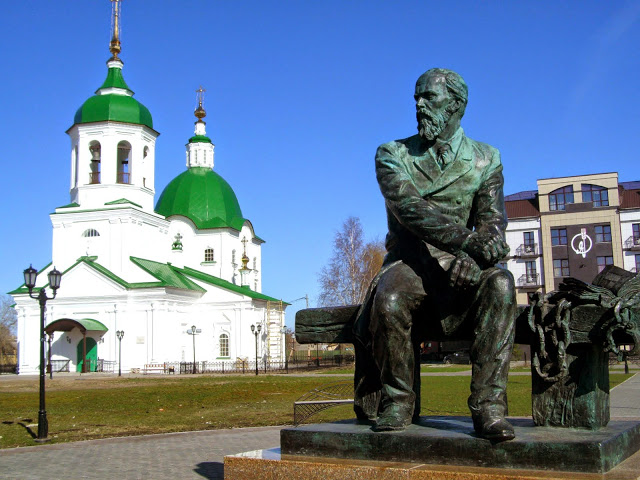
The monument to Fedor Mikhailovich Dostoevsky in Tobolsk is located in the square of the eponymous square next to the Temple of Peter and Paul. Open October 29, 2010. The monument was operated by Mikhail Pereyaslavets - a full member of the Russian Academy of Arts, the People's Artist of the Russian Federation, Professor of the Department of Sculpture of the Moscow State Academic Institute named after Surikov.
The monument made from Bronze shows the Dostoevsky Sitting on the bench, who spent 10 days in Tobolsk in 1850 in a forwarding prison on the road to Katorga in Omsk. Next to the writer on the bench lay the prison chains and the gospel, which Natalia Fonvizin gave him, the wife of the Decembrist Mikhail Fonvizin. The writer sits on a coarse wooden deck, he has a tired view, rough from heavy work.
The place of installation of the monument was approved by members of the historic Council Tobolsk, since Dostoevsky was in the area in the renovation.

Monument to the Russian writer Fyodor Dostoevsky is located in the Garden of Sculptures in the courtyard of the restaurant "Hermitage" (ul. Olminsky, 18).
Fedor Mikhailovich Dostoevsky is one of the most significant and well-known Russian writers and thinkers in the world, worldwide glory has come after death.
Friedrich Nietzsche admitted that Dostoevsky was the only psychologist from whom he could learn something ("Twilight idols").
Memorial boards
For many addresses, where F. M. Dostoevsky lived and worked, memorable boards were established, in particular in St. Petersburg in the following homes:
- 1971 - Vladimir Prospekt, 11 (House K. Ya. Pinicnikova) from the county alley, 10: "In this house from 1842 to 1845, Fedor Mikhailovich Dostoevsky lived. Here they were written Roman "" "
- 1956 - Blacksmith Lane, 5/2 (House of W. K. Kuchina), now the Writer Museum: "In this house in 1846 and from 1878. On February 9, 1881, Fedor Mikhailovich Dostoevsky lived. Here they were written Roman "" "
- 2000 - Voznesensky Avenue, 8 (Apartment House Ya. X. Shile)
- 1995 - 3rd Krasnoarmeyskaya Street (former 3rd Rota Izmailovsky Regiment, 5) From Egorova Street, 8: "At this place there was a profitable house in which the Great Russian Writer F. M lived in 1861 from March 1860 . Dostoevsky and worked on "Notes from the Dead House" and Roman "" »
- 1998 - Treasury Street, 7 (Previously Profitable House I. M. Alonkin on Malaya Meshchanskaya): "Fyodor Mikhailovich Dostoevsky lived in this house in 1864-1867. Here is the novel "Crime and Punishment". " Here was a novel "Player"
- 1986 - The board on the facade was the "Wiesbadskaya Waters" reminiscent of the fact that the Roman "Player" was created in Wiesbaden
- 2006 - in Vilnius on the building of the hotel on DJ O 20, in 1867, on the way to Berlin, F. M. Dostoevsky and Anna Grigorievna, was opened, a memorial table of the sculptor Romualdas Quintas was opened. Subsequently, Dostoevsky briefly visited there on the way from St. Petersburg to Western Europe and back
Dostoevsky was in Florence twice: with N. N. Insurance in the summer of 1862 and from December 1868 to June 1869 with his wife Anna Grigorievna. On Pitti Square ( Palazzo Pitti) At home number 22 there is a memorial plank: "Somewhere here at the turn of 1868 and 1869 Fedor Mikhailovich Dostoevsky completed the novel" "" (Ial. In Questi Pressi Fra IL 1868 E IL 1869 Fedor Michailovic Dostoevckij Compí Il Romanzo "L`Idiota"). Already after establishing a commemorative board, N. P. Doghin discovered the record of Dostoevsky in the library with an indication of his valid address in Florence: Gwichchardini Street ( Guicciardini.), 8. Roman "Idiot" Writer completed on January 17, 1869.
Zone Dostoevsky
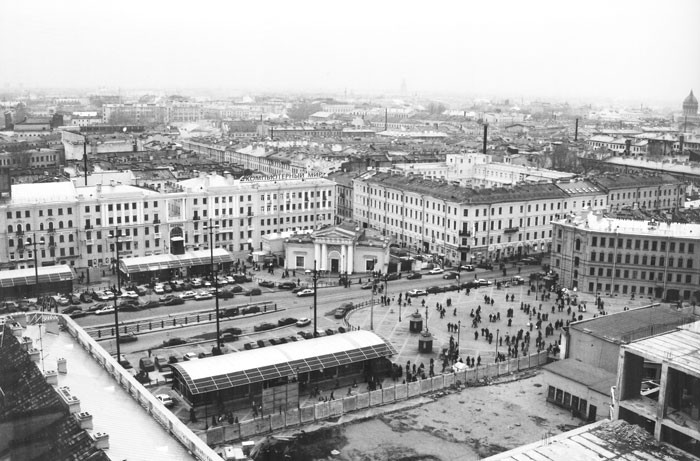
"Dostoevsky zone" is so informally referred to as the area of \u200b\u200bthe Square in St. Petersburg, which is closely connected with the work of F. M. Dostoevsky. In homes No. 1, No. 7 (a memorable board was established) and No. 9 for the Treasury Street, a writer lived, and in the house number 1 in the apartment of Brother Mikhail, the editorial office of "Time" and Epoch magazines "was located.
Here on the streets, alleys, prospects, on the square itself, on the Catherine Canal, the actions of a number of works of the writer ("", "and others) are unfolded. In the houses of these streets, Dostoevsky settled his literary characters - Rodion Romanovich Skolnikova, Sonya Marmaladov, Svidrigaylova, General Epanchin, Rogozhin and others.
On a civil street (former Middle Meshchanskaya) in the house number 19 (the corner of the joiner, 5), according to Koreadov "lived" Rodion Raskolnikov. In many guidebooks in St. Petersburg, this building is as "House Skolnikov", at the corner of which the burner F. M. Dostoevsky was installed on July 7, 1999.
"Zone Dostoevsky" was established in the 1980s-1990s at the request of the public, which caused the city authorities to put in order the memorable places located here, which are associated with the name of the writer.


